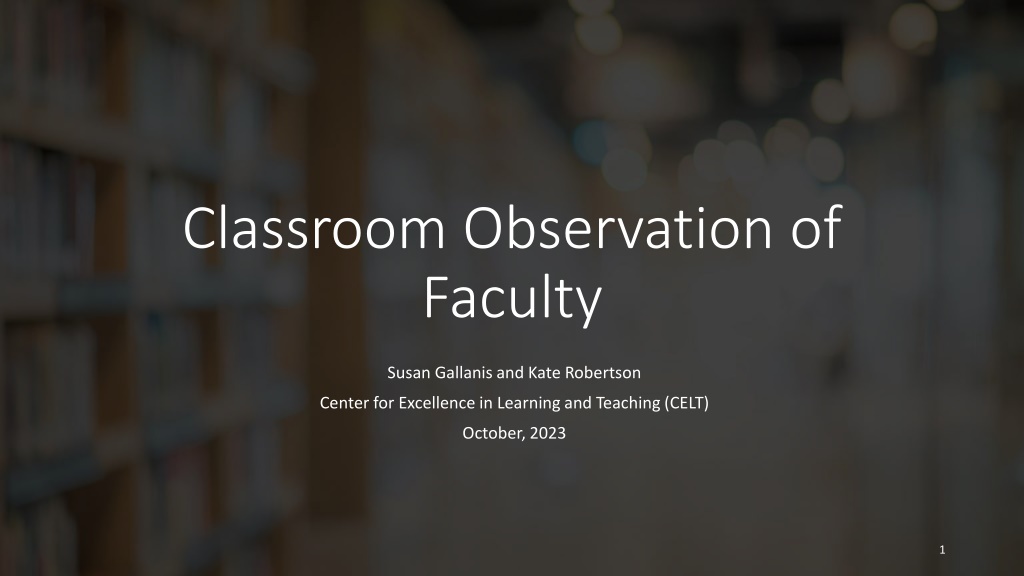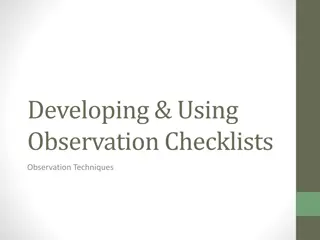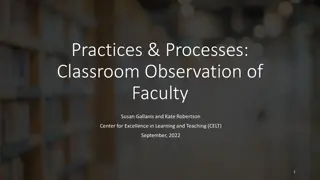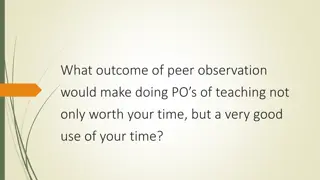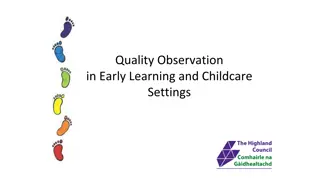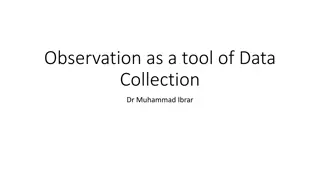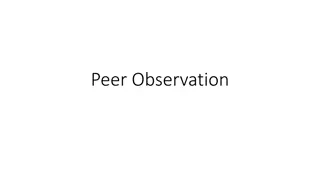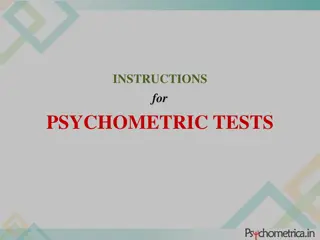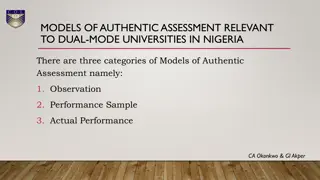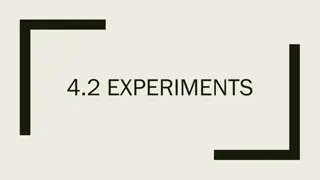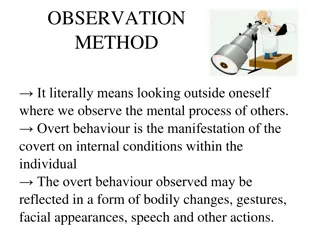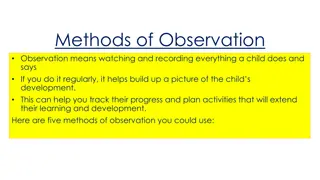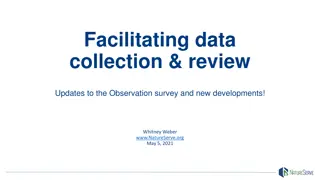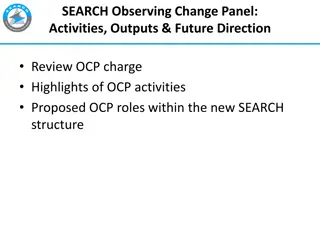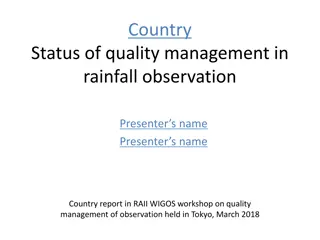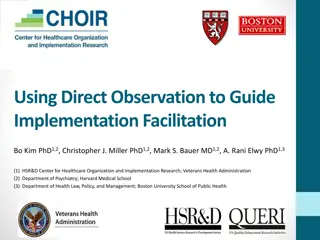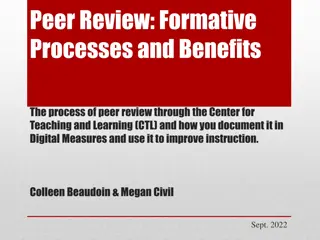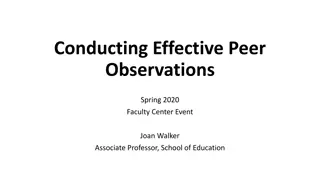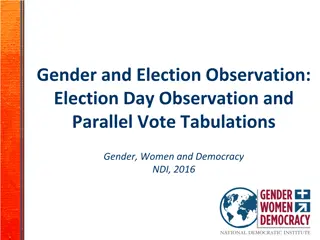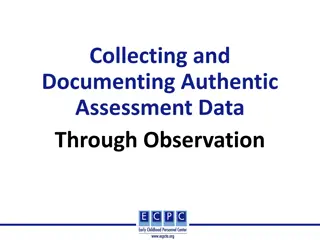Teaching Observation Process and Best Practices
Explore the teaching observation process with a focus on fostering faculty success and improving teaching practices. Learn about pre-observation meetings, separating observation from evaluation, and utilizing observations to spark dialogue about effective teaching. Access resources such as the Teaching Observation Form from the Center for Excellence in Learning and Teaching (CELT) blog. Gain insights from faculty perspectives on conducting observations effectively.
Download Presentation

Please find below an Image/Link to download the presentation.
The content on the website is provided AS IS for your information and personal use only. It may not be sold, licensed, or shared on other websites without obtaining consent from the author.If you encounter any issues during the download, it is possible that the publisher has removed the file from their server.
You are allowed to download the files provided on this website for personal or commercial use, subject to the condition that they are used lawfully. All files are the property of their respective owners.
The content on the website is provided AS IS for your information and personal use only. It may not be sold, licensed, or shared on other websites without obtaining consent from the author.
E N D
Presentation Transcript
Classroom Observation of Faculty Susan Gallanis and Kate Robertson Center for Excellence in Learning and Teaching (CELT) October, 2023 1
Introductions Type in the chat Your name Are you a new director/chair at CUWAA Have you completed an observation of faculty (any type, anywhere) 2
Objectives Locate the Teaching Observation Form Become familiar with the four-part observation process Develop your style of objectively documenting what you observe Separate what you observe from your opinion or evaluation Use the observation process to spark dialogue about effective teaching and build up your faculty 3
Classroom Observations Good? Bad? Stressful? "Personally, I want the observation to be an opportunity for success for the instructor, and one part of instructor s overall teaching evaluation. Other? Tim Macafee (Communication) 4
Teaching Observations Purpose Improve teaching/Spark dialogue about effective teaching Build up your faculty! Relationship building Scope Classroom, virtual, online Formative or Summative 5
The Teaching Observation Form Find on the CELT Blog (with additional resources): http://celt.cuw.edu/teaching-observation-process-and-form/ Find the form (only) in the Forms Repository of the portal 6 categories, no checklists, 3 ratings for summative observations "Going through steps one time made understanding steps much easier to me. Tim Macafee (Communication) 6
Part 1 Pre-observation meeting Summative: Chair/Director discretion In person, Zoom meeting Email No prior notification Which class What date Formative Do set up a meeting; instructor chooses course and date, learn about the course, etc. "Personally, I prefer scheduled visit compared to spontaneous visit. Tim Macafee (Communication) 7
Dr. Meghan Watry-Christian Faculty Perspective: Pre-observation meeting https://cuwaa.hosted.panopto.com/Panopto/Pages/Viewer.aspx?id=f c4d6bdf-ad83-4cf5-a192-b09a01635beb 8
Part 2 The observation Document the way that works best for you Blank paper (hand write) Type while observing Pages 2 8 of the form as a workspace Aim for 2 3 examples for most categories Not sent to Academic Office: your notes, pages 1-8 Formative: Pages 3 8 shared during post-observation meeting "Take copious notes during class time. Then, copy/paste and edit notes into appropriate categories when filling out the observation form. Tim Macafee (Communication) 9
Part 2, cont'd. Objectively document what you see/hear (evidence, data) Judgement statements (negative) easy to disagree with; how can I learn from it to improve my teaching? Judgement statements (positive) feels great, but how can I use it to improve my teaching Separate what you see/hear from what you think about it. "Took me the first instructor observation to understand how to write initial objective notes, without subjectivity Tim Macafee (Communication) 10
Just the Facts: What is happening in the classroom What you think: Opinion, questions, suggestions Objectively Document: Separate Fact from Opinion 8:00 Greets class; Here is the agenda for the day 8:02 Review; What do you remember about the electoral college? - couple students in back talking how to engage them? 8:04 Other review questions: What happened during the 2000 election ? 3 students respond - nice job asking clarifying questions. Good follow up to stretch thinking. 8:07 Instructor begins video 11
Dr. Meghan Watry-Christian Faculty Perspective: Note taking style and using the form. https://cuwaa.hosted.panopto.com/Panopto/Pages/Viewer.aspx?id=d 8c8f0bf-2aff-4544-aebe-b09a0164031a Link to blog post with 22-minute video referred to during interview: https://celt.cuw.edu/teaching-observation-process-and-form/ 12
Evidence or Opinion? Excellent introduction! I heard "In summary" at end of major topics. Nice rapport with students Instructor called on students to respond based on color of the day Not a good storyteller Enthusiastic Included relevant examples Clear transitions between major topics. Consistent use of student names Seems like face-paced talking during lecture I heard "I'm so impressed with how brilliant you are!" (students chuckling) Very organized Seems disorganized Lecture portion of class followed the order of the learning objectives presented at start of class 13
After the observation Before post-observation meeting Review/organize your notes. Assign examples a category, if needed Aim for 2 3 examples/category Elaborate on your feedback, if needed Document preliminary ratings (summative only) Each category Overall rating (page 8) Document your top 1 3 suggestions Document and share this information in the way that works best for you. This documentation is not submitted to the Academic Office. "Take time to reflect on my objective notes and potentially personal biases before selecting ratings and providing recommendations. Tim Macafee (Communication) 14
Part 3 Post-observation meeting/dialogue Best practice is to have a post-observation meeting and meet in person. Discuss the evidence What was effective? What was not effective? Are there other options? Do you have questions? Relate evidence to best practices. Share your ideas. Ask clarifying questions; this may affect preliminary ratings. Summative only Share preliminary ratings and top 1 3 suggestions or recommendations. Don t want the faculty member to be surprised with what is submitted to Academic Office. 15
What's my (opening) line? There was a clicker question and 35% answered correctly and 35% picked B (incorrect). What are some options for using this information as a learning moment? I had trouble following that story, example, etc. How do you think this went? What was your goal with that __? (activity, slide, mini-lecture, question) How do you think that group activity went? Did it go as planned? I noticed (x) strategy for student participation. What are some other options? I've tried ___. Are you concerned about student participation? I noticed you lectured for 50 minutes straight; I noticed opportunities for students to paraphrase - Retrieval practice can be an effective learning activity. I noticed lots of students browsing internet or on their phone. 16
Part 4 Summative Only Complete Teaching Observation Summative Evaluation form (pages 9 11) Share with instructor Encourage instructor to complete Post-Observation Reflection (page 11) Completed and signed Observation form (pages 9 11) emailed to Academic.Office@cuw.edu. Formative/Peer Share notes only No ratings Pages 9 11 not completed 17
Dr. Meghan Watry-Christian Faculty Perspective: Final Tips https://cuwaa.hosted.panopto.com/Panopto/Pages/Viewer.aspx?id=6 7b61340-bec7-4b44-bdd6-b09a016462cc 18
Resources Nine Principles of Good Practice Bloom's Taxonomy Observation and Bloom's Taxonomy (reference guide) Retrieval Practice CELT Blog Resources of Best Practices 19
Thank you! 20
